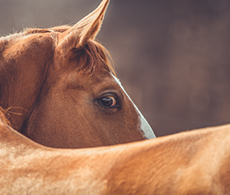
How to build your horse’s topline
A horse's topline is vital for strength and performance. Champion event rider Lucinda Green explains how to assess and develop your horse's topline.
Your horse’s topline plays an important role, supporting both the horse’s spine, and the rider, and facilitating movement. So, what is a topline and how can you develop it in your horse?
What is a horse’s topline?
The topline is the group of muscles that run along a horse’s spine from the top of the neck to the wither area, down the back and loin, and over the top of the hip into the croup region.
The purpose of these muscles is to hold the spine firm when the horse is generating force through its hindquarters, such as when they are galloping away from prey. If the topline is weak, the horse isn’t able to move or perform effectively and is predisposed to injury.
How to recognise the topline
It can be hard to distinguish fat from muscle, but usually, if the horse has got a fatty crest on its neck, it will have fat pockets in other places, too, such as over their loins, shoulders and tail head. Condition scoring your horse can help you decide if they are carrying excess fat.
‘When assessing topline, we are looking for a rounded shape, like a bow and string with the string in a straight line at the bottom along the horse’s tummy and the bow arched up like a bridge above it,’ says six-time Badminton winner Lucinda Green. ‘There should be no prominent bony processes other than the withers and the profile across the back should be slightly rounded.’
In a horse with a poor topline, you can see the spinous processes prominently and the pelvis looks very angular. The top of the tail and sacrum look concave, too.
Building topline
Before starting any muscle-building programme, you should firstly rule out pain, which should include saddle and bit checks and foot balance, as well as a physical examination by a vet. If a horse is in pain, it won’t work correctly and won’t build muscle.
Once pain has been excluded, you can begin working your horse in the right posture using exercises that will help to develop the correct muscles.
‘The correct posture is where the head and neck are slightly lowered and the ears are level with the withers,’ explains Lucinda. ‘The neck should be horizontal and the nose slightly in front of the vertical. When the horse is in the correct posture, they will activate their core muscles and lift up through their back. They should flex their hindlimbs so they bend through their hip, stifle, hock and fetlock as they swing their leg forward. We also want them to reach forward underneath their body and tuck their pelvis in with each hind step, which creates hindlimb engagement.’
Lucinda offers four ways to help build your horse’s topline:
- Stretching – engaging the tummy muscles
When warming up, incorporate moments when you work your horse in a stretching frame amid transitions. This is a great way to engage the horse’s core, lift the tummy muscles and strengthen the back. You want the horse stretching into a soft contact, dropping from the withers, working forwards and pushing from the hindlegs. Once the horse is working nicely in a stretched frame, you can then gradually ask the horse to work up into a contact, and go on the bit. At the end of the session, you can then stretch them again. It's important that the horse isn't simply loading the forehand – they must be using their hindquarters and working over their back. - Groundwork – stepping under with the hindleg
Begin by leading the horse on a small circle in walk, with a forward and down head carriage, the horse bent around you and stepping underneath with their inside hindleg.
As the horse turns, you want them to step their hindleg forward and underneath their body, which will then encourage them to lift up through the core into the carrying posture. You can progress that into a shoulder-in along a wall by asking for a gentle sideways movement. - Hill work – working the hindquarter muscles
A great way to build a topline under saddle is hill work. Riding up and down hills works the muscles in the hindquarters, the back and the abdominal muscles. A slow trot or walk is most beneficial in the early stages.
Downhill is just as good because the horse has to control their descent and flex the hindlegs to step under their body and shift their weight backwards. You want a nice slow descent, allowing the horse to balance itself. Allow freedom of the horse’s head as long as it isn’t too high or hollow. - Polework – flexing the joints
Polework is terrific at encouraging the horse to engage their core, flex their joints and round and lift their back. Place various lines of poles around the arena, some raised at either or both ends, and walk and trot over them. Put a few different lines out, with different numbers of poles at different heights.
Correct nutrition
‘Building topline also requires the correct nutrition,’ says Lucinda. ‘In order to build muscle, your horse needs to be in a positive energy balance, which means they are receiving slightly more energy in the form of forage, such as good meadow hay and chaff, than they need for the work they are doing. It's important not to overfeed your horse with high-energy concentrates as this could make them too excitable, so ensure you speak to your vet and nutritionist to discuss your horse’s feeding plan.
‘It is also worth ensuring your horse is free from a worm burden as this could affect their condition.’
How do you build your horse’s topline? Share your ideas and suggestions on our Facebook page and get tips and advice from other owners.



